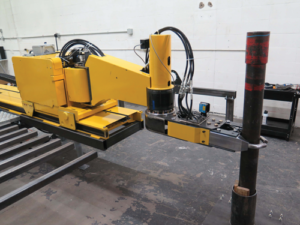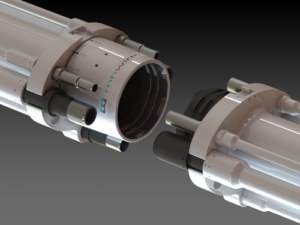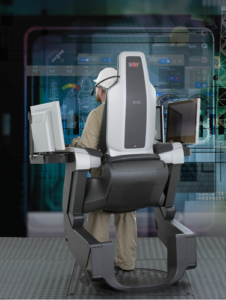Rig briefs: Robotic arm for automated pipe handling, 20,000-psi riser system, ergonomic driller’s station among industry innovations
Machine adopts LIDAR sensors from auto industry

The best derrickmen in the drilling business can rack a stand of pipe at an approximate rate of about 20 seconds per pipe at the start of a tour, according to RigArm, a Calgary-based drilling equipment manufacturer. However, fatigue then begins to set in and can affect performance. “If somebody is standing on top of the rig and needs to move around 200 pipes, the speed will deteriorate over time as they get tired,” Vlad Jorgic, RigArm Co-Founder, President and Software Developer, said. To automate pipe handling on double and triple land rigs, the company is developing the Intelligent Hydraulic Pipe Handling Robotic Arm. “Our goal is for the operator in the control room to be able to tell the machine what to do and allow the machine to complete the entire sequence.”
The hydraulically powered robotic arm, which weighs just under 2,000 lb, would be bolted onto the rig’s racking board and controlled from the driller’s cabin. It can rack a stand of pipe in an estimated 20-25 seconds, according to the company.
The machine will be equipped with a light detection and ranging (LIDAR) sensor and two ultrasonic sensors, located at the tip of the arm, to scan the racking board and precisely locate each stand of pipe. This will help to prevent any equipment collisions. “It senses where the pipe is and then it reaches for it. We have realized that you can’t rely on things being at fixed positions on drilling rigs, so the machine is able to navigate to find the pipe,” Mr Jorgic said.
Ultrasonic sensors are already commonly used in the oil and gas industry, but LIDAR sensors are a relatively new technology being borrowed from the automotive industry. Although LIDAR technology has been available since the 1960s, LIDAR sensors did not become widely used until the manufacturing industry adopted them in the 2000s. Since 2010, the automotive industry also has begun using the sensors to assist in the development of autonomous car prototypes.
Mr Jorgic said his company recognized the similarity between how an autonomous car must react to road conditions and how the robotic arm would need to react in a drilling operation, leading to the adoption of LIDAR sensors for RigArm. “The conditions on drilling rigs are demanding and uncertain. Things move, shake and you can expect that nothing will go as expected, so we needed a system that can understand these changes and quickly adapt on its own, which is what LIDAR technology allows.”
The main challenge in developing the robotic arm has been refining algorithms to allow the arm to properly locate the pipe. Mr Jorgic said the company is experimenting with algorithms that coordinate with cameras mounted onto the robotic arm to scan a three-dimensional image of the environment. If one of the device’s sensor readings doesn’t match the 3D scan, the system’s algorithms will ignore data from the faulty sensor in order to keep the machine operational. “The machine is much different than traditional robotics where everything is preprogrammed. This actually uses motion-planning algorithms that allow it to basically program itself based on changes in the environment.”
The robotic arm has been tested in a lab, and the company is now seeking to test the machine on a North American land rig for at least six months. “We would like to get the machine onto a live well to prove it can work reliably in the field,” he said. “Proving the reliability is very important because we’ve seen mixed feelings from drilling contractors who have worked with these types of machines and have not been successful – which is maybe why we still see a lot of manual pipe handling.”
Mr Jorgic emphasized that this robotic arm is not something that the derrickman would operate remotely with joysticks, which can be challenging to control. The pipe-handling sequence would be carried out autonomously by the robotic arm once the driller pushes a button in his cabin. Pending the field trial, Mr Jorgic said, the robotic arm is expected to become commercial for the North American market by 2017.
-— By Alex Endress, Editorial Coordinator
Click here to watch the robotic arm complete a trip-out sequence autonomously.
Next-generation riser system can operate at up to 20,000 psi

To meet market demands for higher performance in riser technologies, MHWirth has developed the QRT 4000 LS drilling riser system. It can operate at up to 20,000 psi and in up to 10,000 ft of water. The water depth rating can be increased to 15,000 ft by using the QRT 5000 LS.
The goal in designing the system was to reduce cost of ownership by reducing maintenance cost and increasing the ability to perform offshore inspections. After in-depth review, the scope of the project was determined as follows:
• Increased possibility to trip more than 10 joints per hour;
• Base the connector on a breech-block principle utilizing a lock ring;
• Maintain connection time as the present system or better;
• Increase stabbing tolerances to reduce stabbing time;
• Replaceable peripheral line boxes and pins without welding;
• Ability to replaceable lock ring on main pipe offshore;
• Ability to inspect critical areas of the connector offshore;
• Reduce critical fasteners to reduce inspection requirements;
• Make the connection scalable from 2,500 kips to 5,000 kips with 15,000- and 20,000-psi rating on kill and choke lines;
• Up to eight peripheral lines;
• Temperature rating of 350°F;
• Distribute load through the kill and choke line;
• Protect the peripheral line seal areas while stabbing to reduce scouring;
• Torque to be taken through the main pipe and not loaded through the peripheral lines;
• Optional hands free connection to optimize HSSE;
• Clear indication on connector indicating when the connector is closed or open;
• Connector design compliance with API 16R, 16F and 16C; and
• DNV-GL and ABS type approval certificates.
After completing the conceptual design, another round of presentations and feedback from users was conducted before finalizing the design. The design work included elastic and plastic analysis of the connector, connector design optimization, kill and choke line thread design, dynamic riser stabbing analysis and riser thermal performance analysis. In addition, dynamic analysis of riser stabbing was performed to optimize the connector self-alignment, obtain smooth and safe stabbing and establish maximum stabbing speed and operating envelopes.
The project underwent qualification and verification in accordance with DNV-RP-A203 “Qualification of New Technology” and API 16R. In addition, ABS helped to establish the qualification program and subsequent testing.
A decision was made to produce prototypes of the 4,000 kips connector and perform the qualification tests on this system first. DNV-GL conducted tests on the connector in Norway, including stabbing and makeup tests, pressure tests to 7,500 psi, connector fatigue tests, system load sharing tests to 5,620 kips and low cycle tests. The kill and choke line threaded connections were fatigue tested at SINTEF in Norway. The qualification tests confirmed the design work and showed that the connector performed better than the requirements. Type approval was obtained from DNV-GL and ABS.
The riser system is designed without high-strength bolts, thus removing the risk for hydrogen-induced corrosion. It can utilize a thermal sprayed aluminium coating for added corrosion resistance.
The spider/gimbal system was redesigned to reduce weight and height. The spider and gimbal are integrated into one unit without any critical welding, thereby reducing the inspection requirements and increasing the possibility to do offshore maintenance and repair. The spider can be outfitted with a hydraulic unit for hands-free closing and opening of the connector and guides.
Tripping speeds reported with the new riser system has been up to 12 joints per hour. Further, MHWirth is working to certify a condition-based maintenance (CBM) system for drilling risers.
— By Lars Bruvoll, MHWirth
Driller’s workstation designed with ergonomics in mind

Many factors can contribute to fatigue in the workplace. For example, wrong postures or sitting for long periods can lead to discomfort in the lower back; incorrect desk or elbow height can trigger wrist pain; and incorrect monitor position can cause neck or eye strain. These symptoms are attributable to poor ergonomics in the worker’s environment. Working under such conditions can prove challenging even for seemingly low risk jobs that simply require use of a computer, mouse and keyboard. Now, imagine performing critical and complex tasks, using multiple monitors and control devices, and doing this for 30 days with 12-hour shifts. Poor working conditions could degrade driller’s performance and ultimately affect the rig’s operation.
A driller’s workstation is the command center for monitoring and controlling drilling processes. For example, joysticks are used to hoist or lower a top drive, buttons activate power slips or pumps, and monitors with touchscreen capability configure machines and provide process status. The ergonomic features of a driller’s workstation play an important role in mitigating driller’s fatigue and reducing the likeliness of joint and back disorders that can lead to long-term pain.
When designing an ergonomically optimal driller’s workstation, it’s necessary to conduct a complete analysis of the tasks that the workstation supports. This information identifies the functionality and placement of the different components that support the tasks, which in turn drives the workstation requirements. Main design requirements to consider include:
• Variation within intended user population: The workstation takes into account the different body measurements of intended users, understanding that drillers can be of any gender and any nationality;
• Visual considerations: The design analysis includes eye-to-screen distances, viewing angles and overall drill floor line of sight;
• Working postures: To achieve optimal ergonomic postures, the workstation requires multiple adjustments to accommodate varying body forms;
• Components’ layout requirements: The layout design minimizes fatigue and avoids unintended activation of controls. The control components are accessible and within arms’ reach; and
• Other considerations: Easy escape from the workstation during emergency situations, easy access to all components for faster service and repair, and installation compatibility with existing driller’s cabins.
National Oilwell Varco’s RISE workstation addresses ergonomic concerns to minimize fatigue and offer drillers the opportunity to work with better posture, less stress and more focus on the job at hand. The workstation includes motors and actuators that provide automatic chair adjustments to custom-fit the operator’s body and provide optimal comfort.
The workstation provides a posture change ranging from any position between sitting and standing. The design captures various incremental physical measurements of the operator, such as line of sight, height, weight, handgrip and arm reach to adjust the workstation and to accommodate the driller. The workstation supports storing and restoring users’ ergonomic profiles, allowing it to self-adjust to a specific operator’s body measurements.
Key features are:
• Adjustments for optimal driller’s ergonomics include: viewing angle of monitors, reach to controls components, backrest inclination, lumbar support, elbow height and width support, knee support and seat height.
• Sitting and standing operation: The workstation provides an integrated motion from sitting to standing positions, while maintaining optimal ergonomics.
• Storing/restoring of user profiles. The software allows a driller to configure the workstation by either entering the body measurements or by individually adjusting each parameter for best comfort. Multiple drillers can save their ergonomic configuration profiles and restore them at any time.
• The control components and layout includes configurable buttons, encoder wheels and an enhanced joystick that optimizes the human-machine interaction during the different drilling processes. The joystick design improves the driller’s grip and includes a tactile feedback to extend the operator’s situational awareness.
— By Nahum Ronquillo, National Oilwell Varco




